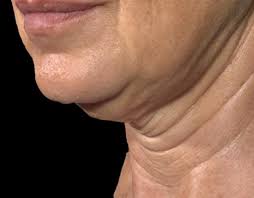
YOUR SKIN CHALLENGE: SAGGING SKIN
No one likes sagging skin. It is unattractive when the skin sags along your jowls (jaw bone), giving an elongated appearance to your face. Sagging skin is one aspect of the ageing process as your body slows down its production of elastin and collagen, which are responsible for maintaining your skin’s suppleness and elasticity.
Causes of Sagging Skin
Sagging skin occurs when your skin’s fat pad, musculature and facial bone foundations change as you age. Your neck is one of the most sun-exposed parts of your body, and one of the first parts of your body to show signs of ageing. Your neck has a thinner skin than your facial skin, less oil glands and a different collagen make up, so pay attention to the skin around your neck. Bear in mind that gravity and muscle activity plays a role and over time skin becomes saggy, with lines and wrinkles starting to appear. This can result in the undesirable “turkey neck” condition. The appearance of sagging skin can be further compounded by a lack of sleep, smoking, being overweight, a poor diet and massive, sudden weight loss.
Prevention
No matter how great your skin is at 25, the inevitable age spots, pigmentation marks, red blemishes and sagging will slowly leave their marks on one’s face by the time one reaches 35. These problems should be addressed early to reduce the downhill progression. Healthy lifestyle choice can also reduce the effects of aging on the skin. For example:
• Ensure you stay out of the sun for long periods of time and wear a high SPF sunscreen when you need to go in the sun,
• Eat healthily,
• Exercise,
• Moisturize your skin,
• Don’t neglect your face and neck toning and moisturizing regimen as neck care is often overlooked when looking after your skin.
Treatment
Sagging skin can be treated and improved in a variety of ways, with an emphasis on improving blood circulation, and the stimulation of collagen and elastin production to restore lost volume. At Dr Bhabha Aesthetics we offer a variety of treatments for every beauty problem. After a consultation with one of our doctors, the appropriate treatment will be recommended and discussed with you in detail. Some of the treatments we offer for sagging skin are:
Fractional Laser is typically done in a series of one to four treatments, spaced four to six weeks apart, depending on the condition being treated, and the severity of the problem. Healing takes between two to five days, and in most cases you will be able to get back to work and apply make-up within two days after the treatment. Find out more >>
Fractional Laser is typically done in a series of one to four treatments, spaced four to six weeks apart, depending on the condition being treated, and the severity of the problem. Healing takes between two to five days, and in most cases you will be able to get back to work and apply make-up within two days after the treatment. Find out more >>
Therapy involves injecting tiny amounts of Carbon dioxide (CO2) beneath the skin to break down fatty deposits and stimulate collagen production. After a treatment the gas is totally reabsorbed within 5 minutes and the treated area will raise, turn slightly red as oxygen perfused into the area which undergoes an inflammatory response which stimulates collagen production. Find out more >>
Treatment consists of the layered application of the peel product. After the peel is removed, a soothing moisturizer as well as a sunscreen will be applied. In some cases, slight swelling, redness, mild itching or stinging can occur, depending on the strength of the peel, but usually ends between three to seven days after the procedure. Find out more >>
Mesotherapy is a soothing cocktail of potent vitamins and anti-oxidants delivered directly into the mesoderm (the middle layer of the skin) via a painless radio frequency procedure. This technology transports the molecules straight into the skin. The treatment has been shown to rejuvenate the skin, reduce fat and help improve skin tone and appearance. Find out more >>
Laser Resurfacing can be performed as a once–off procedure for a more dramatic result or as a series of smaller, individual treatments with less down time. Your healing time will depend upon the size of the treated area, and the depth of the resurfacing. You may experience Erythema (redness), which may last several weeks. Healing time varies among individuals.
